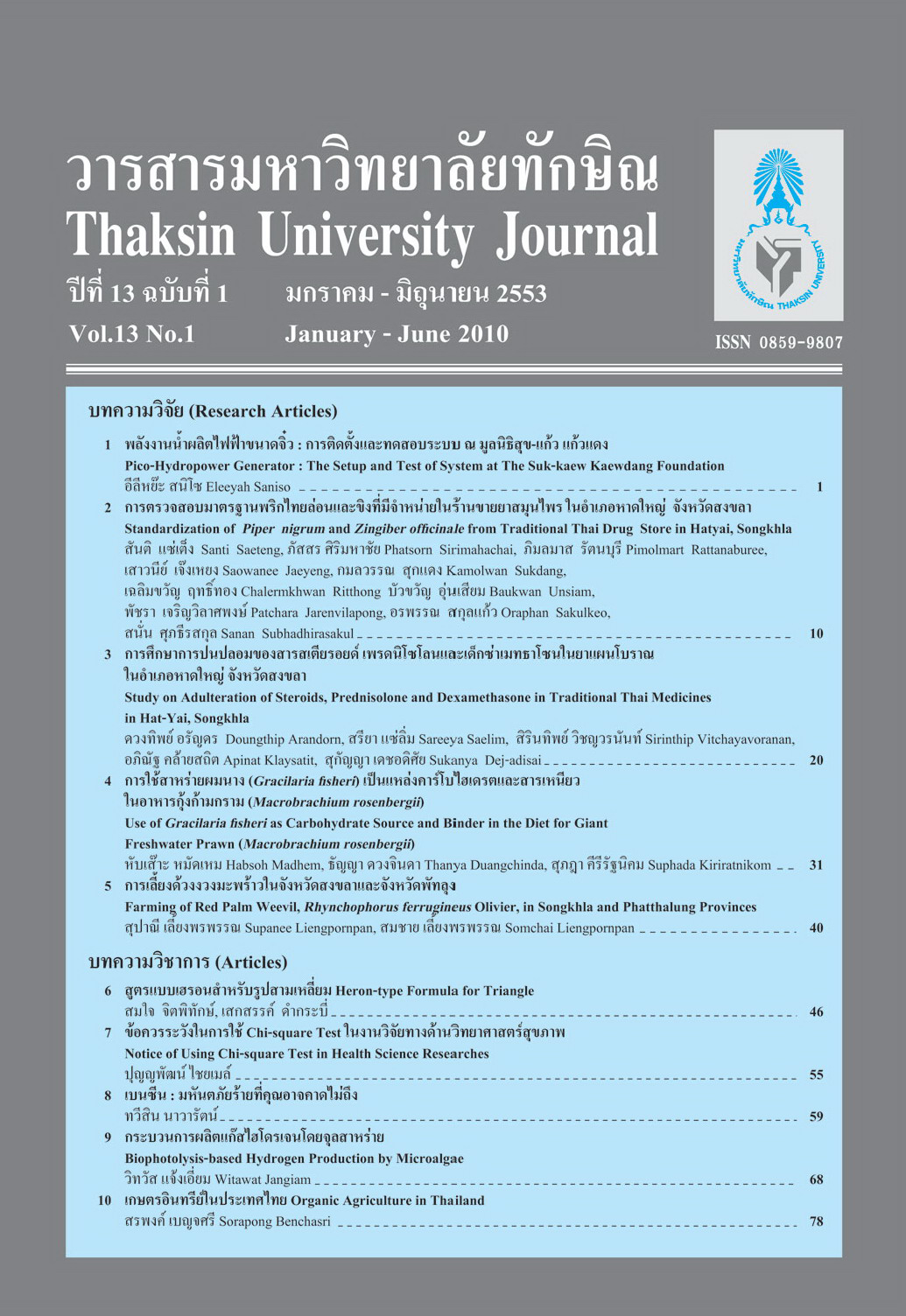การศึกษาการปนปลอมของสารสเตียรอยด์ เพรดนิโซโลนและเด็กซ่าเมทธาโซนในยาแผนโบราณ ในอำเภอหาดใหญ่ จังหวัดสงขลา
Main Article Content
Abstract
งานวิจัยนี้มีวัตถุประสงค์เพื่อศึกษาการปนปลอมของสารสเตียรอยด์เพรดนิโซโลนและเด็กซ่าเมทธาโซน ในยาแผนโบราณ ในอำเภอหาดใหญ่ จังหวัดสงขลา โดยได้ทำการสุ่มเก็บตัวอย่างในช่วงเดือนสิงหาคม ถึงเดือนธันวาคม พ.ศ. 2551 รวมทั้งสิ้น 200 ตัวอย่าง จากแหล่งจำหน่าย จำนวน 54 ร้าน จากนั้นนำตัวอย่างที่ได้มาตรวจสอบหาการ ปนปลอมสารเพรดนิโซโลนและเด็กซ่าเมทธาโซน ด้วยเทคนิค Thin-layer chromatography (TLC) ซึ่งจะต้องทำการ เปรียบเทียบระหว่างตัวยาแผนโบราณและสารอ้างอิงมาตรฐานเพรดนิโซโลนและเด็กซ่าเมทธาโซนทุกครั้ง ผลการทดลองพบว่า 4 ตัวอย่าง ตรวจพบการปนปลอมของสเตียรอยด์ คิดเป็น 2% ของตัวอย่างทั้งหมด โดยตรวจพบ สารเพรดนิโซโลนจำนวน 1 ตัวอย่าง และสารเด็กซ่าเมทธาโซนจำนวน 3 ตัวอย่าง คิดเป็นร้อยละ 0.5 และ 1.5 ตามลำดับ ซึ่งกลุ่มยาที่มีความเสี่ยงในการตรวจพบการปนปลอมด้วยสารสเตียรอยด์ คือ กลุ่มยาที่มีสรรพคุณแก้ปวดเมื่อยและ แก้อักเสบ ทั้งนี้ตัวอย่างที่ตรวจพบการปนปลอมเป็นตัวอย่างที่ไม่ได้ขึ้นทะเบียนยาทั้งหมด และแหล่งที่มาของตัวอย่างคือ ร้านค้าแผงลอยในตลาดสด ซึ่งมีความเสี่ยงสูงสุดที่จะได้ยาที่มีการปนปลอมสเตียรอยด์ คือร้อยละ 5.56 ของแหล่ง จำหน่ายทั้งหมด
The objective of this research is to study on adulteration of steroids, prednisolone and dexamethasone in Traditional Thai medicines (TTM) in Hat-Yai, Songkhla. Two hundred samples were collected randomly from 54 stores during August to December 2008. Common adulterants, prednisolone and dexamethasone were examined in the samples by using thin-layer chromatography (TLC) technique, and compared with prednisolone and dexamethasone standards. The results showed that 4 samples were adulterated with steroid, calculated as 2%, 1 sample was adulterated with prednisolone and 3 samples were adulterated with dexamethasone, calculated as 0.5 and 1.5%, respectively. The risk group of TTM, which contained steroid adulterants was usually using for analgesic and anti-inflammation. These adulterant samples were not registered and the booth in market fair was, which high risk to find adulterant samples as 5.56% from all sources of TTM.


